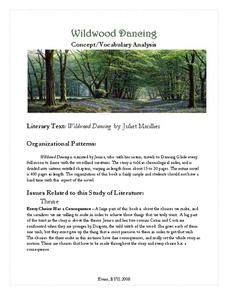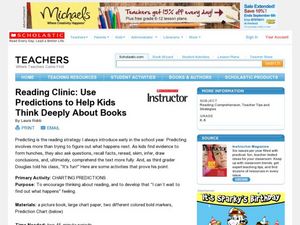Scholastic
Follow the Clues
Invite your text detectives to bring their magnifying glasses to school to examine the clues in a text and make predictions. They write down three clues and a prediction on the graphic organizer.
K12 Reader
The Legend of Sleepy Hollow
Washington Irving's description of Ichabod Crane provides young readers with an opportunity to demonstrate their ability to identify the main idea of a passage.
Curated OER
Lee and the Bee Flee to the Tree
Practice the strategy of decoding to become fluent readers with young scholars. They interact with the correspondence ee=/E/ as it deals with speech and text. The tongue twister, "Why did Lee and the bee flee to the tree?," is also...
Curated OER
Nothing But the Truth: Response Journal
Readers of Avi's young adult novel, Nothing But the Truth reflect on events in the story through a series of journal responses.
Novelinks
Wildwood Dancing: Concept/Vocabulary Analysis
Considering including Juliet Marillier's young adult novel, Wildwood Dancing as part of your language arts curriculum? Check out an overview that examines some of the themes and issues presented by the novel.
Curated OER
Note-Taking and Organizational Strategies
Students explore note taking. For this study skills and nonfiction comprehension lesson, students complete a two column main idea chart while reading a nonfiction passage.
Curated OER
Strategies for pre reading, during reading, & after reading
Fourth graders participate in a lesson using the whole reading of text. They work on skills like prediction and summary. The predictions in particular are analyzed and changed as needed when summarizing.
Curated OER
Reading Clinic: Use Predictions to Help Kids Think Deeply About Books
Students learn to use prediction to think more deeply about literature. In this reading comprehension lesson, students chart predictions in order to more fully understand text.
Curated OER
Reading Comprehension
First graders listen and read along as a story is read to them. They discuss what they read when finished with the text. Students discuss the story vocabulary and the word meanings. They practice decoding unknown words and complete a...
Curated OER
Picture It!
Students participate in visualization exercises as a reading comprehension strategy. As the teacher reads a poem, the students visualize the setting, then read the poem "Daddy's Making Dinner" and create a drawing of what they visualize...
Curated OER
A Novel Study Unit for The Cay
Novelly written questions are perfect for a novel study guide unit on The Cay. The well-rounded resource contains an anticipation guide for scholars to complete before reading, a variety of questions per chapter of the book, and a post...
Curated OER
Vocabulary Bingo: Fever 1793
Prior to reading Fever 1793, class members are introduced to vocabulary drawn from the text of Laurie Halse Anderson's novel with a bingo-style activity. The vocabulary list, a teacher copy with definitions, and the bingo template are...
Curated OER
Origami Ducks: Geometry, Listening, and Following Directions
Make origami ducks with your class to reinforce geometry concepts and vocabulary; develop fine motor and visual translation skills; and enrich study of Japanese culture, the pond habitat, or migration. Create a whole group "worksheet"...
Curated OER
Shizuko’s Daughter: Before, During, After Lesson Plan
Shizuko's Daughter by Kyoko Mori presents a vivid picture of Japanese culture and history. As kids read through the third chapter, they find novel-specific vocabulary to enhance their understanding and use context clues to determine...
Curated OER
What is effective communication?
Students practice a series of communicaton activities. In this communication skills lesson, students role play listening and active listening strategies to improve communication. Students write a set of guidelines for improving...
Curated OER
Improving Elementary Reading Literacy
Students enhance their literary skills through phonemic awareness. For this reading development lesson, students read several storybooks and analyze the phonetics, vocabulary, and overall story. The students then rewrite what they have...
Curated OER
Rain
First graders practice oral and silent reading using beginning comprehension and decoding strategies. In this guided reading lesson, 1st graders take a picture walk and make plot predictions prior to reading the book Rain by Robert...
Curated OER
Daily Lesson Plan for a Struggling Reader
Strategy-based programs that are executed with consistency are the best for achieving growth in any learner with a learning disability. Here is a seven-step lesson plan that is highly structured and is intended to help learners with...
Curated OER
Reading is Fun
Students explore the benefits and joys of reading. They review the reading comprehension strategy cross-checking. They then are introduced to the library and are encouraged to check out an independent book they would independently...
Curated OER
Picture This: Visualization
Sixth graders practice visualizing and understanding that visualization is an important comprehension strategy. They share their visualization of the story, "All the Places to Love", through original artwork.
Curated OER
To Sum It All Up...
Students one main goal when reading is to comprehend, and one strategy to improve reading comprehension is summarization. As students begin reading expository texts, it is vital for them to be able to pick out and summarize the main...
Curated OER
What Are We Reading for Again?
Students work to develop comprehension strategies. Through modeling and guided practice they develop a series of questions as they read Where the Wild Things Are. They apply these questions to find answers about the text and make...
Curated OER
The Who, What, When, Where, and Why of Reading
Students work to develop comprehension strategies. They focus on the five 'w' questions for summarizing: who, what, when, where, and why? Through modeling and guided practice, they apply these questions to summarize several passages.
Curated OER
Mississippi Trial, 1955: A Request Strategy for Questioning
Knowledge, comprehension, application, analysis, synthesis, evaluation. Class members use Bloom's taxonomy to craft six levels of discussion questions for Chris Crowe's novel, Mississippi Trial, 1955. Model questions from Chapter 3, a...
Other popular searches
- Active Listening Strategies
- Comprehension Strategies 1st
- Listening Skill Strategies
- Listening Strategies
- Comprehension and Strategies

























